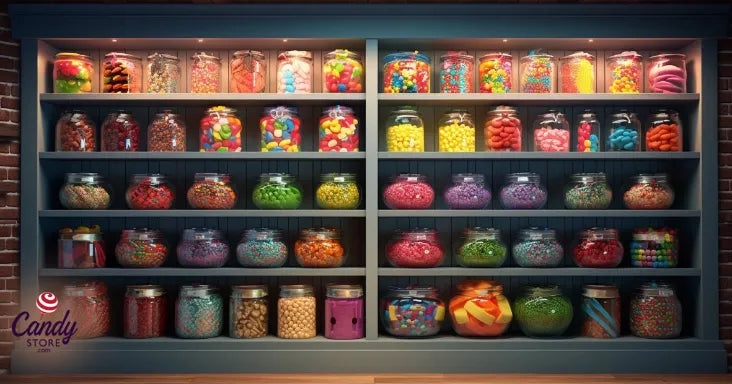How long is candy good after expiration date? Can it really go bad?
The quick answer is yes, candy can go bad. But it's a little more nuanced than that.
Candy is a general term that encompasses a great variety of sweet confectionary products. The degree and speed with which candy will go bad, depends on what it is. So let's break it down.
TL;DR - How Long Is Candy Good For?
Store your candy in a cool – room temp or slightly less – and dry place. If it contains nuts or chocolate, it'll expire faster. If not, the less moisture and fat that type of candy has, the longer it will last. Upper end on lifespan for the most persevering candies is two years, but most are about 6 months.
Here are some general guidelines on how long candy lasts before you should consider throwing it out.
Does Candy Go Bad? Understanding Candy Expiration
Everyone has experienced that agonizing moment: you've found a long-forgotten candy bar in the back of your pantry, your taste buds start tingling, but a shadow of doubt crosses your mind -- has it gone bad?
While it might not pose a significant health risk as spoiled dairy or meat would, candy can indeed "expire" in its own sugary way.
Let's unravel this confectionary conundrum.

Most candies are essentially a magical concoction of sugar, flavors, and sometimes, fats. That type of thing isn't perishable in the conventional sense. This is primarily because sugar -- the heart and soul of candy -- is a natural preservative. It wards off the growth of bacteria and molds, giving candy a commendable staying power.
But here's the crux -- while bacteria might not find candy a hospitable environment, time and conditions can turn your delectable treat into a disappointment.
So, while your long-lost candy bar might not send you running to the doctor, it might not deliver the desired explosion of flavors either. In candy terms, "going bad" essentially means losing its taste, texture, and visual appeal -- factors that play a crucial role in our candy-crunching experience.
And let's be real, a tasteless, misshapen candy is as bad as any spoiled food. After all, what's a candy if it can't take you on a nostalgic ride to your best childhood memories?
Detecting Spoiled Candy: Signs and Indicators
So you've found an old bag of Skittles that's been lying around for quite some time. While the child in you might be doing a happy dance, your adult self might be wondering, "Can I still taste the rainbow?"
Before you decide to embark on this adventure, it's important to know how to spot the signs of expired candy. Understanding these indicators can help you avoid a less-than-tasty experience.
Discoloration
Firstly, keep an eye out for any discoloration. Over time, candy can lose its vibrant hues and become dull or blotchy. If your Skittles look less like a rainbow and more like a rainy day, it's best to let them go.

Texture Changes
Another tell-tale sign is a change in texture. Hard candies can become sticky or even soft, while chewy candies can harden over time. If your Skittles have morphed into tiny rocks or transformed into gooey blobs, they're past their prime.
Tastes Funny
Taste, of course, is the ultimate deciding factor. If there's a significant change in flavor or if the candy tastes off, it's time to bid farewell. Keep in mind that it's perfectly okay to take a small taste to judge this -- you're unlikely to get sick from a tiny piece of expired candy.
Chocolate, Nuts or Fruit?
Lastly, be extra vigilant with candies containing nuts, chocolate, or fruit, as these carry a risk of mold after some time. While it's unlikely that your Skittles will turn moldy, if you come across a chocolate bar with signs of mold, it's best to err on the side of caution and throw it away.
Ingredients matter when you're evaluating the shelf life of a candy.
The Role of Ingredients in Candy Shelf-Life
So, you've just returned from a candy shop search adventure, arms laden with all your favorite treats, including an extra-large pack of gummy candy. Now you're probably wondering how long this sugary haul will last. The answer, interestingly, lies within the candy itself -- its ingredients.
Sugar, the quintessential candy ingredient, is not just there for its sweetness. It's a natural preservative that can extend the shelf life of many foods, including candy. It can make some dry hard candies stay good for years!
Does Sugar Go Bad?
The simple answer to the question, "Does sugar go bad?" is no, it does not.
This is because sugar, whether it's white, brown, or powdered, is a low moisture food. Its dry nature makes it an inhospitable environment for bacteria, yeast, and other microorganisms that are the usual culprits behind food spoilage.
This means that sugar can technically last indefinitely if it's stored properly.
However, while sugar doesn't spoil or go bad in the traditional sense, its quality and texture can change over time. Brown sugar, in particular, can harden when its limited moisture evaporates.
This doesn't mean it's spoiled, and there are several methods to restore its soft texture, like placing a slice of bread or an apple slice in the container with the hardened sugar.
In the case of powdered or confectioners' sugar, which often has added cornstarch, you also want to prevent any moisture from getting into the container because it could cause clumping.
What About Other Ingredients?
But as we know, candy is not all about sugar. Other ingredients like fats, fruit extracts, and nuts not only contribute to the flavor, texture, and shape of the candy but also influence its shelf life.
For instance, candies with high fat or dairy content, like chocolate, may not last as long as sugar-based candies due to the propensity of fats to become rancid over time.
Gummy candy, for example, while it may seem harmless, often contains ingredients like gelatin and fruit concentrates, which can break down and lose their quality over time, leading to changes in taste and texture.
Candies containing nuts or fruit also warrant extra caution. These ingredients, delicious as they may be, can potentially introduce moisture into the candy, increasing the risk of mold over time.
In short, when it comes to the longevity of your sweet treats, it's not just about the candy type but also what goes into them. Understanding the role of ingredients can help you make better decisions about candy consumption and storage.
Effect of Heat and Moisture on Candy
Let's say you have a stash of candies you wanna keep fresh for a long period. You choose some that you think are primarily sugar and not nuts or chocolate to shorten their lifespan: jawbreakers, Sour Patch Kids, and Jolly Ranchers.
You want to make these goodies last, but there's a villain lurking in the shadows: heat and moisture.
Temperature and humidity might seem like trivial factors, but they wield a considerable influence over your candy's longevity and quality. Too much heat, and you risk a meltdown. Your Jolly Ranchers might transform from a hard, long-lasting treat into an unpleasant, sticky mess.
Moisture is another culprit to watch out for. The sugar in your candy can draw in moisture from the air, leading to issues like crystallization and unpleasant texture changes. That pack of Sour Patch Kids, once a parade of individual sour, chewy delights, could morph into an unappetizing sugary lump in humid conditions.
And what about cold temperatures? You might think that your freezer is the perfect refuge for your candies, especially the heat-sensitive ones like chocolate. However, freezing can cause problems of its own. It could lead to the formation of "chocolate bloom" -- a whitish coating on your chocolates caused by the cocoa butter separating from the sugar.
How Different Types of Candy React Over Time
Just like us, candies age and they do so in their unique ways. From the vibrant jelly beans to the rich Reese's Cups, and the varied selections of bulk candy, each type responds differently to the passage of time.

Hard candies, like lollipops or mints, hold up relatively well. With their minimal moisture content, they resist decay for quite a while. However, they can still lose their flavor over time and become sticky or softer.
Chewy candies like jelly beans have a somewhat shorter shelf life. The sugar that makes them so delightfully chewy can eventually crystallize, turning them hard and gritty.
Nut or fruit-based candies are prone to going moldy, given enough time. These types of candy should be consumed more quickly and stored with care.
Now, I know what you might be asking...
Does Chocolate Go Bad?
Surely, it must be a crime for chocolate to go bad. I mean, it's chocolate! But alas, even the most heavenly treats have an earthly timeline.
So, how do you know when your chocolate has decided to turn to the dark side (and not in a rich, cocoa way)?
First things first, let's clarify one thing: chocolate doesn't exactly expire or 'go bad' like a carton of milk or your week-old leftovers. It's not going to suddenly transform into a science experiment or grow a new ecosystem.
But it can get old, and its quality can degrade over time, causing changes in texture, color, and taste. Ever notice a whitish or grayish coating on the surface of your chocolate?
Don't panic, that's just 'chocolate bloom'. It happens when sugar or fat rises to the surface after the chocolate has been stored at fluctuating temperatures. While it may look like your chocolate got a sudden case of frostbite, it's still safe to eat. However, the texture may be a bit crumbly and the taste might have lost some of its original lushness.
And what about those tiny white dots or streaks? That's 'fat bloom', caused when the chocolate gets too warm and the cocoa butter melts and resettles on the surface. It's a little like your chocolate got a mild case of acne. Again, it's perfectly safe to eat, but the smooth creaminess we love about chocolate might be somewhat compromised.
Remember, these changes don't usually mean that the candy is unsafe to eat. But they can certainly detract from the taste and texture that we love in our sweets.
How Long Do Gummy Bears Last?
We get asked this one a lot, so we're singling them out.
Gummy bears, like many candies, have a long shelf life due to their sugar content which acts as a preservative. If kept in their original, unopened packaging and stored in a cool, dry place, gummy bears can remain fresh for 6-12 months.

Once the package is opened, it's best to consume them within 7-10 days for optimal flavor and texture, though they can last longer if resealed properly.
Factors like exposure to air, heat, and humidity can reduce their freshness over time. Storing them in airtight containers or resealable bags can help extend their lifespan.
It's important to check for signs of spoilage like changes in texture, color, or odor. If gummy bears become too hard or have an off smell, it's best to discard them.
The Process of Candy Supply: Ensuring Freshness
In a world where freshness is king, how do your favorite sweets make it from the factory to your candy bowl, while still retaining that mouth-watering freshness we all crave? The secret lies in the process of candy supply and the stringent measures taken by reputable candy suppliers.
Candy manufacturers aim to move their products from production lines to candy stores near you as quickly as possible, and for good reason. Fresh candy is a delight to savor, and the rapid turnover ensures that the candy you buy is as fresh as possible.
Suppliers that focus on bulk candy, for example, often get their stocks straight from the factory. These candies then embark on a speedy journey to reach consumers, often within days of their production. This fast-paced operation means that candies, like those irresistible gummy candy treats, arrive at the stores in peak condition.
This practice isn't just good for candy lovers, but also for the suppliers themselves. A higher stock turnover means less chance for candies to sit past their prime on the shelves, which helps the supplier maintain a reputation for quality.
But not all candies move at the same speed. While popular candies might fly off the shelves, others may take a little longer to sell. Suppliers usually identify these slower-moving items and ensure they don't overstock them. This way, they can focus on keeping a fresh and fast-moving inventory.
It's clear that when it comes to candy supply, speed and turnover are critical for freshness. The next time you're hunting for the perfect sweet treat, remember to appreciate the swift journey it's made to ensure peak flavor and enjoyment.
Proper Candy Storage Guidelines
Storage is key to keeping your sweet treats fresh and delicious. You've found the perfect candy store near you, made your candy selection, and now it's time to take the right steps to ensure your candy doesn't lose its delightful flavor and texture.

Here are some best-practice guidelines to follow:
- Room Temperature: Candy, particularly chocolate, is not a fan of heat. Store your candy at room temperature, ideally between 60 and 70 degrees Fahrenheit. This prevents your candy from melting or becoming sticky.
- Dark and Dry: Keep your candy in a dark, dry place to prevent moisture from getting in. Moisture can lead to stickiness, loss of flavor, and even mold in some cases. A pantry or cupboard is typically a good choice.
- Avoid the Fridge: While it may be tempting to stash your jelly beans or Reese's Cups in the fridge or freezer, beware. Cold temperatures can cause chocolate to "bloom" -- a white or gray film forms as the cocoa butter separates from the sugar.
- Air-Tight Containers: Store your candy in an air-tight container. This will prevent your candy from drying out and helps maintain its texture and flavor.
- Separate Different Types: Avoid storing different types of candy together. Flavors can migrate, and you don't want your sour candy tasting like chocolate, or vice versa!
Remember, how you store your candy can have a big impact on its taste and texture. Follow these guidelines and you'll be well on your way to enjoying your sweet delights for as long as possible.
In Conclusion
Well, there you have it! The journey of candy from factory to your taste buds is quite a ride, filled with the science of sugar, the art of preservation, and the importance of proper storage.
Each type of candy has its own quirks and needs, but with a bit of care, you can ensure that your treats stay fresh and delicious as long as possible.
Remember, not all candies are created equal, and the secret to enjoying your sweets to the fullest lies in understanding their nature and respecting their shelf lives.
So, the next time you're indulging in your favorite treat, know that a little candy wisdom goes a long way in preserving that sweet experience. Enjoy!
Disclaimer: Always consult your physician on matters that relate to your health. We do not recommend eating candy that is not fresh. This is a candy blog. We are not doctors, and will not be responsible for any candy eaten that may cause discomfort or illness.
Share This Post
-
Tags:
- Candy News

